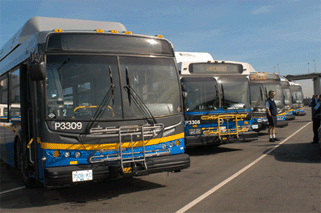Building Canada - Modern Infrastructure for a Strong Canada - Infrastructure and the Environment
Infrastructure and the Environment
Maintaining a healthy and sustainable environment is directly related to the health and prosperity of Canadians, and the federal government has set the protection and promotion of a clean environment as a paramount national objective. Infrastructure investments can be a powerful tool for achieving environmental goals. Better infrastructure planning and construction can reduce the impact of human activity, and help protect and improve the environment.
A 1997 report compiled for the National Air Issues Coordinating Committee estimated that reducing SO2 (sulphur dioxide) emissions by 50 percent in eastern Canada (approximately 1 million tonnes) would avoid 950 premature deaths, 1,530 emergency room visits, and 209,350 asthma symptom-days.
Quoted in Options for a Clean Environment and Healthy Canadian Economy, 1997 (PDF Version, Size: 1.12 MB)
Air pollution is estimated to cause at least 5,000 premature deaths each year in Canada,6 with personal transportation being among the main causes of air pollution. Shifting a larger portion of this traffic to public transit can improve air quality by providing an alternative to driving that is energy efficient and lower in emissions. A transit rider creates 65 percent lower greenhouse gas emissions than an auto user for the same trip, and commuters who take transit just twice a week can reduce their emissions by 25 percent.7
Energy generation is another major contributor to air pollution in many areas of the country. In general, Canada has one of the most diversified electricity generation bases in the world. Sources include natural gas, oil, coal, nuclear power, and hydro-electricity and other renewable energy. However, there is an increasing need to make Canada's energy supplies and technologies cleaner and more efficient.
Canada, because of its northern climate and dispersed geography, relies heavily on energy to heat and light homes and buildings, as well as for transporting people and goods. Historically, a large portion of this has been secured through fossil fuels. As a result, Canada is one of the largest per-capita emitters of greenhouse gases in the world. And this reliance on fossil fuels also has serious consequences for the air we breathe. We will also be required to assess the impacts of future climate change on our nation's infrastructure.

Translink Buses, Vancouver, BC
Studies show that new rapid transit investments have the potential to significantly increase transit ridership and – importantly – attract new transit users away from their cars. For example, the introduction of the 98-B Bus Rapid Transit (BRT) line in Vancouver in 2003, along with accompanying transportation demand management measures, induced a 23 percent mode shift from auto to transit on the corridor, resulting in a net increase of 1.2 million passengers per year. In addition, in a 2004 survey, 42 percent of Vancouver SkyTrain riders reported that they were former auto users.
(Transport Canada, Cost and Impacts of Transit Investments, January 2005)
Water pollution is another major environmental challenge and municipal wastewater effluents are one of the largest sources of pollution to Canadian waters.1 Although 84 percent of inland municipal populations in Canada that are served by sewers receive secondary or tertiary wastewater treatment, only a minority of coastal communities served by sewers have secondary treatment, with most having only primary or no treatment at all.9
In addition, the cost of treating health problems related to water pollution is estimated at about $300 million per year.10 Again, effective modern infrastructure is needed to ensure sufficient processing and purification of wastewater, both for the protection of human health and to ensure the long-term viability of Canada's aquatic environments.
[6] Health Canada, Estimated Number of Excess Deaths in Canada Due To Air Pollution, April 2005.
[7] Canadian Urban Transit Association, Public Transit: A Climate Change Solution, Issue Paper 16, December 2005.
[8] Environment Canada, Water Pollution
[9] Environment Canada, Environmental Signals: National Indicator Series 2003, 2003.
[10] Environment Canada, Water: Quick Facts
- Date modified: